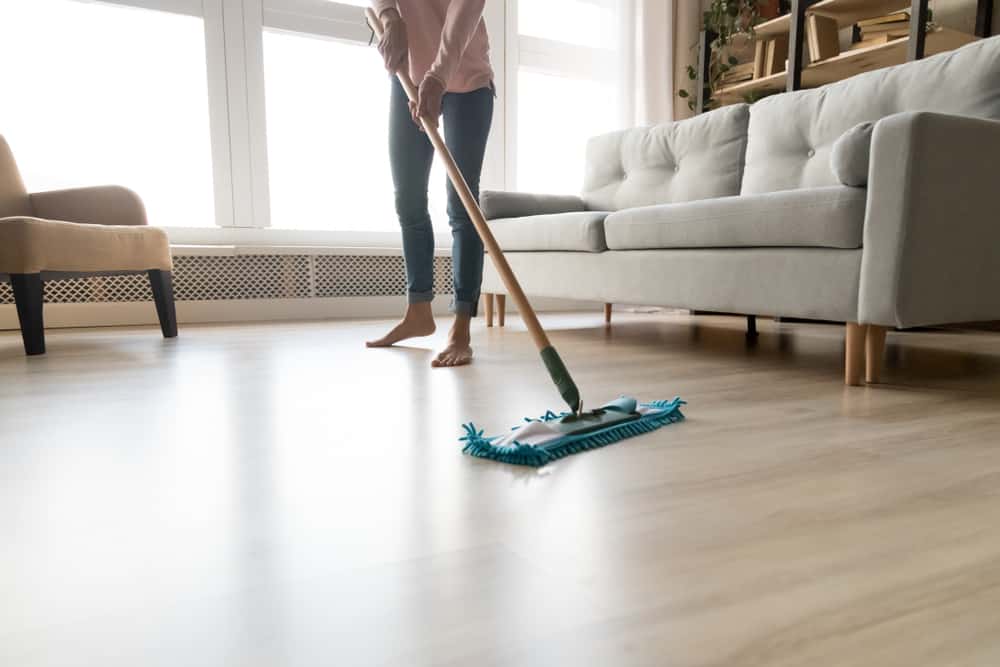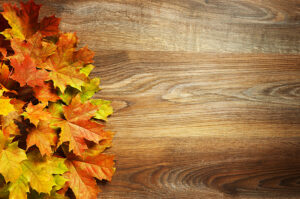
The ultimate guide to cleaning and looking after laminate floors
Everyone loves a hardwood floor, but many of them are not solid wood all the way through. Rather, they are laminate – an engineered wood flooring solution that is stronger, more versatile, more hygienic and more cost-effective than solid wood. Increasingly popular and suitable for DIY installation, laminate floors are often the perfect solution.
While they are well known as much tougher and more resistant to stains than wooden floors, that does not mean laminate floors don’t still need careful maintenance.
This article is your guide to:
Before we get into that, we must first explain a little of how laminate floors are made and what are the common sources of damage.
What are laminate floors?
A hybrid floor covering, laminate flooring is installed much like real hardwood – multiple boards joined with a tongue-and-groove system. Unlike hardwood flooring, however, a piece of laminate flooring is made up of multiple layers:
- A wear layer of durable plastic that protects the layers below
- A pattern layer that gives the floor its attractive appearance
- A core layer (also called a substrate) made of high-density fiberboard (HDF) to give the floor its heft and shock absorbance
- A balancing (or backing) layer that works as a moisture barrier and stable base.
Laminate flooring is a popular solution for those who want the aesthetic of hardwood or stone flooring without the exorbitant price tag.
Common sources of damage to laminate floors
Laminate flooring might be more durable than traditional wood floors, but it’s still possible to damage or stain it if you’re not careful. The damage can range from surface-level blemishes to multi-layer penetration. The staining can be simple grime through to bleaching.
Here are some common sources of damage to laminate flooring:
Water damage to laminate floors
Less is more when it comes to water on your laminate flooring – yes, even while cleaning. While properly installed laminate floors will be as water-tight as possible, excess water will seep in. Left unchecked, this can cause your planks to swell, damaging your floor irreparably.
Using the wrong cleaners
Incorrect usage of cleaning products is almost always the culprit of chemical damage to laminate floors. The wrong cleaner can dull the look of your laminate floors or worse, eat away the protective upper layers.
Vacuuming and sweeping
Dirt is a universal enemy and the same goes for dirt on your laminate floor. Regular sweeping and vacuuming are essential to keep the abrasive action of dust and debris from dulling the finish of your laminate.
That said, vacuuming or sweeping the wrong way can also deal damage. Vacuum with the brush roller switched on and it will cause micro-scratches to build up on your floors. The same goes for sweeping with a bristle broom, no matter how soft.
Houseplants
Keeping your indoor plants watered is great for the plants, but it only takes a bit of spillage to go a long way to damaging your laminate flooring. And the larger the pot, the bigger the area that’ll be masked until it’s too late!
Sunlight
A sun-dappled house may look great on Instagram, but harsh sunlight that hits your laminate floor in a regular pattern every day can gradually fade out sections of your chosen style in the pattern layer.
Heavy furniture
That perfect statement piece might just be making a statement gouge in your laminate flooring. Furniture without proper furniture pads is a no-no when it comes to laminate. This goes double if it’s a piece you get a lot of use out of such as couches or tables. Just the act of pulling out a chair every day can build up to hefty damage over time.
The best way to clean wood laminate floors? Prevention!
The optimal way to keep your laminate floors clean is to stay on top of routine maintenance. Consistent once-over cleaning will keep them in much better condition than an occasional attempt at a deep scrub. Here is what we recommend.
Sweep or vacuum
The simplest of all floor-cleaning routines. Dirt doesn’t just affect the look of your home, it also causes tiny scratches in laminate that build up to dull the surface of your floors. You should sweep or vacuum your laminate flooring at least once a week.
To ensure your broom or vacuum isn’t scratching your floors, employ the use of a soft dust mop and ensure your vacuum’s brush is in the ‘up’ setting.
Wipe up spills ASAP
Laminate floors seem like they are totally waterproof, but they’re not. Liquids will seep in over time (think of those small leaks that can build up under fridges). The best advice is to clean up the spill and then use a completely dry cloth or paper towel to remove all dampness.
Word of caution:
You’re cooking breakfast and splat! One half-cooked pancake or egg or spoonful of mushrooms hits your laminate floor. DO NOT use a metal implement to scrape it up. Instead, only use wood or plastic implements.
Wash with plain hot water
Hot water really is an effective cleaning agent for floors: it cuts grease, melts dirt and is lethal to microbes. As it contains no harsh chemicals, there is little chance of it damaging your floors. A monthly wash-down is usually sufficient if you’re also following a weekly sweeping routine.
As laminate floors are sensitive to water, it’s important though to wring your mop out until it is just damp, not wet, when you apply it to the floor.
The experts say:
“Never use abrasive cleaners, soap, detergents, waxes or polishes on your laminate floors.”
However, if you want the best-of-the-best for your floors, see the next section down: The best products for cleaning laminate floors.
Always use saucers under your houseplants
Water damage to laminate flooring can be catastrophic, so it’s important you prevent water exposure where possible. Houseplants should always sit in a saucer to catch any excess when watering or seepage through the pot.
Close the blinds during the harshest times of day
Sun bleaching of laminate floors is a tricky customer – often people don’t realise what’s happened until they move their furniture and find two-toned laminate. To help prevent sun damage, ensure you close your blinds against the sun during the harsh midday and early afternoon hours.
Apply furniture pads
Furniture pads are an oft-overlooked godsend when it comes to maintaining your laminate flooring. Without them, you risk scratches or even large gouges in your floor. So, do yourself a favour and spend the extra few dollars on preventative furniture pads. Your laminate floors will thank you.
Golden rule:
Always have doormats for people to wipe their shoes on. Tracked-in dust and dirt is the major cause of a tired-looking laminate floor.
NEVER use a steam mop
While there are some conflicting reports about whether a steam mop is a good choice for laminate flooring, our advice is simple: don’t. While laminate floors are high-tech, they are still made from wood. The searing temperatures and the excess water just don’t agree with their construction.
You don’t have to go far to find stories of people ruining brand new laminate floors in just a few months of well-meaning but misguided steam mopping.
The best products for cleaning laminate floors
If you stay on top of regular cleaning, there should be no reason at all to use strong floor cleaners on your laminate flooring. They won’t make your floor cleaner, they will just damage its finish and make your house smell like a hospital.
However, there are specialised laminate floor cleaners available and most are formulated to rejuvenate your floor’s shiny appearance. However, if your floor only needs a clean, why not make the solution yourself? The recipe is simple and the ingredients can be found around the home.
Simple laminate floor cleaner:
- 1 part white vinegar
- 10 parts warm water
- A few drops of dish soap.
Method: Combine the ingredients in a spray bottle and mix well. Use sparingly in small sections. Your floor shouldn’t really get ‘wet’, just damp enough for the solution to loosen the dirt and dust. The vinegar may smell, but it is the necessary ingredient to prevent streaks. With ventilation, the odour vanishes quickly.
Always remember:
When you clean your laminate flooring, you’re only cleaning the top layer, not the wood underneath.
Dealing with stains, marks, and spills
The good news about laminate flooring is that most spills wipe straight off. However, there are times when certain kinds of stain require a different approach.
How to remove scuff marks from laminate flooring?
One of the greatest home cleanliness secrets lives right on your desk – the humble pencil eraser. Soft white erasers of good quality have an almost magical ability to remove marks from smooth surfaces. On a laminate floor, heel marks and shoe scuffs usually rub right off.
How to remove blood stains from laminate flooring?
Act fast! Blood contains proteins that begin setting immediately on contact with both air and warmth. Soak up the blood as best you can without wiping and then spray some window cleaner on the stain and then wipe this up with a soft damp cool cloth. You should use the minimum amount of wiping possible – blood smears easily and sets more quickly when spread thin.
How to remove coffee and wine stains from laminate flooring?
Black coffee and red wine tend to make for worse stains than their white counterparts, but either way, the steps are the same. Soak the excess liquid up immediately and then use the laminate cleaning solution sparingly to wipe off the rest. Wipe with the grain.
How to remove felt pen from laminate flooring?
Remarkably, a good-quality pencil eraser can often wipe pen marks off your floor with only a little elbow grease. If that doesn’t work, dab some nail polish remover onto a soft cloth and gently work at the marks. Be sure to remove any excess chemicals from your floor when finished.
How to remove crayon from laminate flooring?
Get as much of the crayon off with your fingernails or a plastic utensil as you can (an old credit card works well). Next, dab some vodka onto a soft cloth and gently buff off the marks. If that doesn’t work, try nail polish remover.
How to remove paint from laminate flooring?
If still wet, soak up as much paint as possible; if dry, remove the excess with a plastic or wooden utensil. Next, use the cleaning solution above to remove as much of the remaining paint as you can. Last, dab nail polish remover onto a cloth and gently wipe away the remaining paint. Once done, wipe all residue of cleaning products off the area.
How to remove fats and oils from laminate flooring?
Quickly chill the area as much as possible. Ice-cubes in a plastic bag work, as does a pack of frozen peas. You want the oil to congeal. Once it has become thickened or solid, scrape it off with a wooden or plastic implement. Remove the residue with a clean damp cloth and window cleaner. Remove all the oil and window cleaner residue and then dry the area thoroughly.
Golden rule:
Remove the stain. Then clean the spot. Then wipe over the spot with plain water. Then dry the spot completely.
How to make your laminate floors shiny again?
After cleaning, laminate floors have a tendency to streak or leave mottled patches – they need a polish!
- Buy a special laminate floor cleaner – regular floor detergent is a no-go
- Sweep or vacuum any dust and dirt off your floor
- Follow the instructions on the bottle – usually, you spray a very small area of the floor directly with the cleaner
- Wipe the area you have sprayed with a microfibre cloth or mop – going with the grain
- Move around the whole floor one small section at a time.
Laminate flooring is worth taking proper care of
Laminate flooring is versatile, attractive, and cost-effective, but, as with any material, it takes a bit of knowledge and care to maintain.
Knowing how to prevent problems before they arise is the key to ensuring your floors look as good in 10 years as they do upon installation.
Having a few tricks up your sleeve to deal with stains, spills and other unsightly marks will go a long way as well.
Problems cleaning your laminate flooring? Stubborn stain you just can’t budge? Contact the friendly team at Parry’s and we’ll be able to help you.
Further reading about laminate flooring:
- Buyer’s guide to choosing laminate flooring
- How to prepare your floor before installing laminate flooring?
- Guide to installing laminate flooring yourself
Read More Blogs
Article Topics
Recent Articles
-
![Parrys Carpets: Rental property flooring: the best choices]()
Rental property flooring: the best choices
Tax time is on the horizon! For those with rental properties, it makes sense at...
Keep Reading -
![Parrys Carpets: Autumn Trends, Colours and Flooring for the Season]()
Autumn Trends, Colours and Flooring for the Season
When autumn arrives and temperatures begin to drop, many of us start thinking about how...
Keep Reading -
![Parrys Carpets: Senior Safe Flooring]()
Senior Safe Flooring
Losing mobility as we age can have many knock-on effects, including impacting the type of...
Keep Reading



